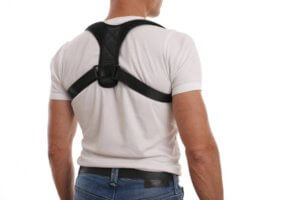COVID-19 PATIENT GUIDELINES
COVID-19 PATIENT GUIDELINES Please click on the link to review our office guidelines in response
keep readingOver the last couple of years, there has been a large increase in the public awareness of braces and correctors to help promote and support posture. These can be seen all over social media, targeted advertisements, or even around your workplace from coworkers using them. The intent of these braces is to promote and hold the shoulders, head, and neck in proper alignment to help alleviate pain and discomfort often seen in those with desk jobs or workplaces where you are primarily working in front of you. That begs the question; should I wear a postural brace to help with my neck and back pain?
First, let’s look at how these braces work. There are two main types of postural correctors. The first provide physical support by pulling your shoulders down and back into a neutral alignment. The second uses digital sensors that remind you to sit upright whenever ‘poor posture’ is identified. Both of these are meant to serve as a type of feedback to cue your muscles to activate properly and thus hold yourself in better posture.
 Do These Work To Improve Posture Or Pain?
Do These Work To Improve Posture Or Pain?A study was conducted on healthy university students compared muscle activation and self-reported pain and fatigue in those who typed at a computer for 30 minutes. The group of students who wore the brace demonstrated significantly less muscle activation when measured with electromyography in the upper trapezius, a muscle that is often facilitated or overused in deskwork. However postural alignment and self-reported pain and fatigue scores were not significantly different between the groups (Leung et al. 2023). Another study demonstrated no improvement in forward head or shoulder angle when using a posture T-shirt (Manor et al. 2016). A third study demonstrated no difference in those who wore postural correctors in combination with education and exercise compared to those who were educated and performing exercises alone (Annaswamy et al. 2021). At this time the research supports that postural braces likely do not provide significant relief or improvement in pain, fatigue, or postural alignment.
As designed, these braces are meant to serve as a tool to help remind you to stay in a neutral, more comfortable alignment, allowing for overworked muscles to relax and improve joint motion. They are meant to bring awareness to your posture so you can begin to activate and strengthen the muscles over time and eventually no longer wear the brace. In theory, short-term use of these braces can help alleviate tension in the upper trapezius muscles which do play a role in conditions like mechanical neck pain. However, it is very easy to use these devices inappropriately and develop a dependence on these. Muscles gain strength with consistent use. When something, in this case the postural corrector, prohibits that muscle from being used, the muscles begin to shrink and weaken over time. This can often cause more complications in the long-term and result in more pain and discomfort.
When it comes to correcting posture, it’s best to use a combination of strengthening, mobility, and educational exercises to improve the way you sit rather than rely on an external brace. Talk to your doctor about your concerns so they can prescribe you a tailored exercise regimen to help you improve your symptoms and help provide you with long-term relief.